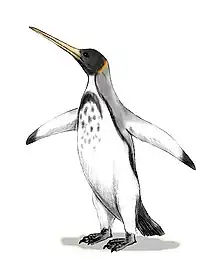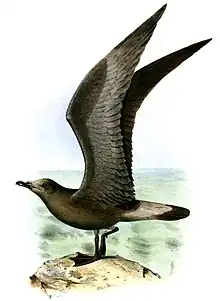| Great albatross Temporal range: Early Pliocene to present | |
|---|---|
| Snowy albatross (Diomedea exulans) | |
| Scientific classification | |
| Domain: | Eukaryota |
| Kingdom: | Animalia |
| Phylum: | Chordata |
| Class: | Aves |
| Order: | Procellariiformes |
| Family: | Diomedeidae |
| Genus: | Diomedea Linnaeus, 1758 |
| Type species | |
| Diomedea exulans Linnaeus, 1758 | |
The great albatrosses are seabirds in the genus Diomedea in the albatross family. The genus Diomedea formerly included all albatrosses except the sooty albatrosses, but in 1996 the genus was split, with the mollymawks and the North Pacific albatrosses both being elevated to separate genera.[1]
The great albatrosses themselves form two species complexes, the wandering and Amsterdam albatrosses, and the royal albatrosses. The splitting of the great albatrosses into six or seven species has been accepted by most, though not all, authorities.[2]
Description
The snowy albatross and the southern royal albatross are the largest of the albatrosses and are among the largest of flying birds. They have the largest wingspans of any bird, being up to 3.5 m (11 ft) from tip to tip, although the average is a little over 3 m (9.8 ft). Large adult males of these two species may exceed 11 kg (24 lb) in weight, as heavy as a large swan.
_heads.jpg.webp)
The great albatrosses are predominantly white in plumage as adults, with birds becoming whiter as they age. The two royal albatrosses at all ages and the larger, older male snowy albatrosses are totally white-bodied, while adult females and younger animals of the other species have dark pencilling marks on the edges of their feathers. Generally the smaller species or subspecies and the juveniles have more dark brown colour. The recently discovered Amsterdam albatross retains the dark brown plumage of juvenile birds into adulthood.
Habitat and range
The great albatrosses range across the Southern Ocean, and nest (for the most part) on isolated oceanic islands. The snowy albatrosses nest on islands around the Southern Ocean, from the Atlantic Ocean (South Georgia and Tristan da Cunha), to the Indian Ocean and New Zealand's Subantarctic islands. The royal albatrosses nest only on New Zealand's Subantarctic islands, with one unusual colony on New Zealand's Otago Peninsula.
Taxonomy
The genus Diomedea was introduced in 1758 by the Swedish naturalist Carl Linnaeus in the tenth edition of his Systema Naturae.[3] The genus name is from Greek mythology. When the hero Diomedes died his companions were turned into white seabirds.[4] The type species was designated as the snowy albatross (Diomedea exulans) by George Robert Gray in 1840.[5][6]
Species
The genus contains six species:[7]
| Image | Scientific name | Common Name | Distribution |
|---|---|---|---|
.jpg.webp) | Diomedea epomophora | southern royal albatross | Campbell Island,Adams Island and Auckland Island in the Auckland Islands |
.jpg.webp) | Diomedea sanfordi | northern royal albatross | Chatham Islands (Forty-fours Island, Big Sister Island, and Little Sister Island), Enderby Island in the Auckland Islands |
 | Diomedea exulans | snowy albatross | South Georgia Island, Crozet Islands, Kerguelen Islands, Prince Edward Islands, and Macquarie Island |
 | Diomedea antipodensis | Antipodean albatross | Auckland Islands, Antipodes Islands and Campbell Island |
.jpg.webp) | Diomedea dabbenena | Tristan albatross | Gough Island |
 | Diomedea amsterdamensis | Amsterdam albatross | Amsterdam Island, part of the French Southern Territories in the southern Indian Ocean, |
Fossils
The earliest known fossils of the genus are from the Middle Miocene, about 12–15 mya. By that time, the genera Phoebastria and Diomedea had already diverged.
- Diomedea milleri (Round Mountain Silt Middle Miocene of Sharktooth Hill and possibly Astoria Middle Miocene of Oregon, US)
- Diomedea sp. (Late Miocene of Valdez Peninsula, Antarctica)[8]
- Diomedea sp. (Early Pliocene of South Africa)[8]
- Diomedea sp. (Early Pliocene of Bone Valley, Florida, US)[8]
- Diomedea thyridata Wilkinson, 1969 (Upper Miocene, Beaumaris Bay Fossil Site, Australia) [10][11]
At least four species were found in the Early Pliocene deposits of Lee Creek Mine, North Carolina in the US.[8] These may in part be identical with the forms mentioned above. Assignment of the undescribed taxa to Diomedea is tentative since most of them were discovered before the splitting of this genus. Especially the Southern Hemisphere species probably belong to other genera.
See also
References
- ↑ Nunn, Gary B.; Cooper, John; Jouventin, Pierre; Robertson, Chris J. R.; Robertson Graham G. (1996). "Evolutionary relationships among extant albatrosses (Procellariiformes: Diomedeidae) established from complete cytochrome-b gene sequences" (PDF). Auk. 113 (4): 784–801. doi:10.2307/4088857. JSTOR 4088857.
- ↑ Rheindt, F. E.; Austin, J. (2005). "Major analytical and conceptual shortcomings in a recent taxonomic revision of the Procellariiformes – A reply to Penhallurick and Wink (2004)". Emu. 105 (2): 181. doi:10.1071/MU04039.
- ↑ Linnaeus, Carl (1758). Systema Naturae per regna tria naturae, secundum classes, ordines, genera, species, cum characteribus, differentiis, synonymis, locis (in Latin). Vol. 1 (10th ed.). Holmiae (Stockholm): Laurentii Salvii. p. 132.
- ↑ Jobling, James A. (2010). The Helm Dictionary of Scientific Bird Names. London: Christopher Helm. p. 136. ISBN 978-1-4081-2501-4.
- ↑ Gray, George Robert (1840). A List of the Genera of Birds : with an Indication of the Typical Species of Each Genus. London: R. and J.E. Taylor. p. 78.
- ↑ Mayr, Ernst; Cottrell, G. William, eds. (1979). Check-List of Birds of the World. Vol. 1 (2nd ed.). Cambridge, Massachusetts: Museum of Comparative Zoology. p. 48.
- ↑ Gill, Frank; Donsker, David; Rasmussen, Pamela, eds. (July 2021). "Petrels, albatrosses". IOC World Bird List Version 11.2. International Ornithologists' Union. Retrieved 12 August 2021.
- 1 2 3 4 5 Olson, Storrs L. (1985): Section X, H, 1. Diomedeidae. In: Farner, D.S.; King, J.R. & Parkes, Kenneth C. (eds.): Avian Biology 8: 208–210. Academic Press, New York.
- ↑ Haaramo, Mikko (2005): Mikko's Phylogeny Archive: Diomedeidae – albatrosses Archived 2006-09-27 at the Wayback Machine. Version of 2005-11-15. Retrieved 2006-09-25.
- ↑ Diomedea thyridata Archived 2012-03-14 at the Wayback Machine. zipcodezoo.com
- ↑ Beaumaris Bay Fossil Site, Beaumaris, VIC Profile. aussieheritage.com.au
Further reading
- Brands, Sheila (Aug 14, 2008). "Systema Naturae 2000 / Classification – Subfamily Diomedeinae". Project: The Taxonomicon. Retrieved 12 Feb 2009.
- Brooke, Michael (2004): Albatrosses and Petrels Across the World. Oxford University Press, Oxford, New York. ISBN 0-19-850125-0
- Tickell, W.L.N. (2000): Albatrosses. Pica Press, Sussex. ISBN 1-873403-94-1
%E2%80%93Wandering_albatross_(Diomedea_exulans)_03.jpg.webp)

